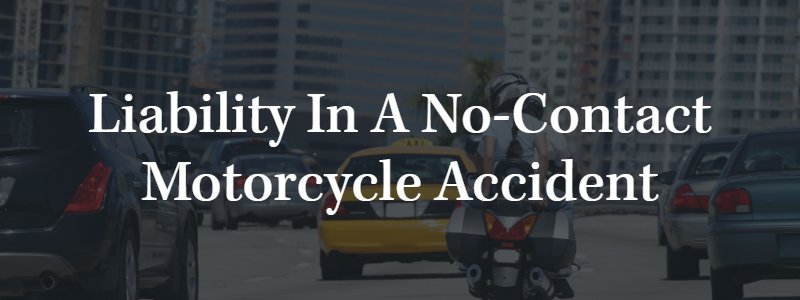Motorcycle accidents are not uncommon throughout the Commonwealth of Pennsylvania. According to the PA Department of Transportation, there were nearly 3,000 total motorcycle crashes across the Commonwealth during the latest reporting year of data available. Out of these incidents, there were 2,860 injuries and 174 fatalities. When most people think of motorcycle accidents, they think of a motorcyclist colliding with another vehicle. However, there are times when “no contact” motorcycle accidents occur. Here, we want to describe what a no contact motorcycle accident is as well as who can be held liable for it and motorcyclist’s injuries and property damage in this situation.

Common causes of no contact motorcycle accidents
A no contact motorcycle accident refers to situations where another person causes a motorcyclist to crash, but there is no actual collision between the two parties. To be clear, no contact accidents can occur between any vehicle, including two passenger vehicles. However, motorcyclists face a much higher risk of no contact accidents than other vehicle drivers. The shape, size, and capacity of a motorcycle mean that riders must maintain certain speeds and maneuver the bike in a certain way in order to stay on two wheels and in a forward motion. It is much easier for a motorcycle to crash without interference from another vehicle than it is for a traditional passenger vehicle.
Vehicle drivers on the roadway could cause a no contact motorcycle crash due to the following:
- Tailgating
- Running a red light or stops signs
- Speeding
- Failing to check blind spots
- Unsafe Lane changes
- Distracted driving
- Reckless driving
- Road rage
- Violating other traffic laws
Common scenarios leading to no contact motorcycle accidents
As we look at the examples above, we can see that no contact motorcycle accidents can occur in a variety of ways. Here, you want to look at two of the most common ways that these incidents occur. For example, if a driver runs through a stop sign and a motorcyclist subsequently swerves and crashes to avoid striking the vehicle, the driver who ran the stop sign could be liable for the motorcyclist’s injuries and property damage. This could be true even if the motorcyclist crashed without ever touching the vehicle. In this example, the driver who ran the stop sign could be held liable for violating a basic traffic law.
Another common example of a no contact motorcycle crash is the unsafe lane change of a motorist. Unfortunately, it is far too common for a vehicle driver to change lanes without checking their blind spot or without using a turn signal, which means they could merge quickly or without warning. This can force a motorcyclist to move into another lane, potentially into another vehicle. This could also force a motorcyclist off the roadway altogether. It is up to drivers to use reasonable care and prudence when operating their vehicles, and negligent lane changes that cause no contact motorcycle accidents could place the liability on the vehicle driver.
Unfortunately, motorcyclists are much more likely to sustain a severe injury in the event they are involved in a crash. It is not uncommon for a motorcyclist to sustain the following in a no contact crash:
- Severe lacerations or road rash
- Broken or dislocated bones
- Traumatic brain injuries
- Open head wounds
- Spinal cord injuries
- Other severe back or neck injuries
- Internal organ damage
- Internal bleeding
- Significant scarring and disfigurement
It is crucial for motorcyclists to obtain compensation if another driver causes their crash. No contact motorcycle accidents can be difficult cases to handle, and it is highly recommended that injury victims work with a skilled Philadelphia motorcycle accident lawyer who can walk them through this entire process.